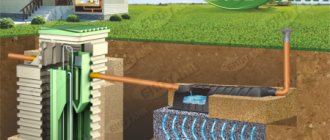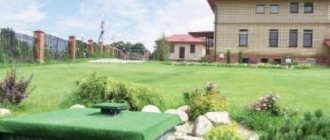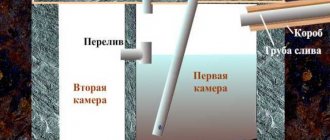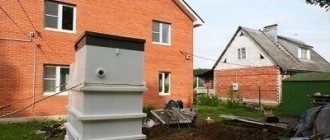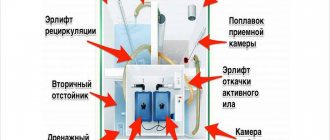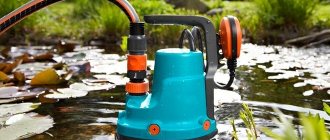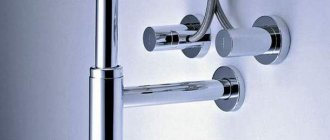What it is?
The septic tank Tank is autonomous and operates without human intervention. The installation occupies a leading position among similar LOS (local treatment plant) in the Russian market. Manufacturer of septic tanks Tank, which offers affordable solutions for a sewer system with any number of drains.
Note! VOCs from the manufacturer are presented in different volumes and numbers of chambers, which accordingly helps them serve different numbers of residents in the house.
Important features of the VOC Tank septic tank:
- The presence of stiffening ribs that guarantee the integrity of the structure even under the most difficult installation conditions.
- The containers (chambers) are cast, which guarantees their strength and tightness.
- The wastewater is processed with a high purification rate, which makes it possible to use it for technical purposes without any problems.
- The sewerage and wastewater treatment system is compact, since there are structures that are located not in breadth, but deep in the soil. But a rectangular, horizontal Biotank can only be installed in areas with deep groundwater.
Important! Horizontal designs are convenient because you can add additional chambers to increase the productivity of the installation.
Advantages of equipment for private homes
Despite the fact that the Biotank septic tank is a relatively new development of the company, it has already managed to gain wide popularity in the Russian market.
to compete with the products of other well-known manufacturers of sewage settling tanks:
- high performance with small dimensions;
- minimum operating costs - the system practically does not require maintenance; to maintain the efficiency and quality of wastewater treatment, only periodic cleaning of the septic tank with sewerage equipment is required (once every 6-12 months, depending on the load);
- reliability;
- possibility of use in any conditions - with different groundwater levels (aquifer) and soil characteristics, in a wide range of changes in climate parameters;
- ease of installation.
In addition, the solutions used in the Biotank septic tank cleaning device and technologies allowed us to achieve advantages over analogues on the market:
- the installation allows for the treatment of wastewater containing paper, food waste (including peelings and peelings), active chemicals and detergents in acceptable concentrations;
- operation of the septic tank is possible in a “ragged” mode, with significant interruptions in the flow of wastewater and power supply (high quality of cleaning is maintained in the absence of power to the compressor for up to a day);
- if there is no power supply for more than a day, the septic tank switches to overflow installation mode, while maintaining the degree of wastewater treatment no worse than 85%;
- the time it takes for treatment facilities to reach operating mode is minimal;
- installation and commissioning of a septic tank can be carried out at any time of the year;
- installation does not require winter preservation.
Classification
The product range is quite diverse. The first classification includes the following types:
- Classic. These are standard multi-chamber settling tanks - they are sealed. There is an overflow system inside that helps the drains move. Such installations are affordable and energy independent. Installing a septic tank This type of tank can handle a small volume of wastewater.
- Station wagon. An improved model, when compared with the classic model, the productivity of this installation is higher. This is possible by connecting additional sections. This will help out those who are going to build another building on the territory or modernize the house.
- The Biotank septic tank has a similar operating principle, but its structural filling will allow for deep biological treatment. There is a compressor inside it that pumps in oxygen, which means you can successfully use bacteria for an aerobic type septic tank. Therefore, it works faster and more efficiently.
VOC device
Tank treatment facilities have the following design:
- The body is made of polyethylene, which is manufactured using the casting principle. The thickness of its walls is 1.5 cm, in reinforced areas that undergo heavy loads - 1.7 cm. The design includes stiffening ribs.
- The body has inlet and outlet pipes and a neck, which is designed to pump out accumulated solid fecal matter. When pumping is not taking place, the hole is closed by a hatch. This protects the installation from debris, rainwater, and snow getting into it.
- Standard installations have 3 chambers, which are designed for different types of cleaning. All elements of the body can be expanded - the so-called block system is used. For example, even the largest septic tank, Tank Universal 4, can be expanded by expanding the chambers.
- Filtration of wastewater occurs in different ways - mechanical, chemical, biological - this is what ensures a high degree of purification.
- All installations, even the Tank mini septic tank, are equipped with a ventilation pipe and valve. The latter is triggered by gas pressure inside. There is an aeration pipe for a drip biofilter.
How does a septic tank work?
Model range Tank
In addition to the division by type, there is a difference in the performance of the Tank septic tank models.
Tank 1
Septic tank Tank 1 microbe is the most compact model in the manufacturer’s line. It is enough to process wastewater from 3 people who permanently live in the house. This system can purify no more than 0.6 m³ of wastewater per day. Septic Tank 1 is an excellent solution for a summer residence.
Tank 2
Septic Tank 2 model is a little more expensive, but at the same time the wastewater processing capacity is higher. This can be installed for 4 people. Septic tank Tank universal 2 processes up to 0.8 m³ per day.
Tank 3
Septic Tank Universal 3 can easily cope with wastewater from 5-6 people at once, so the possibilities of its use are wider than just for a private house or cottage. Processes up to 1.2 m³ per day in its chambers. Septic tank Tank 3 has a useful volume of 3000 liters, its weight is 150 kg, so installation will require the use of special equipment. At the same time, the Tank 3 septic tank is extremely easy to use and very reliable. This model can be used with different options for arranging infiltration fields.
Tank 4
Septic tank Tank 4 is the largest and most productive model. Such a “monster” can process wastewater from 7-8 people living in the house at the same time. The total volume of the tank is 4000 l, and the daily productivity is 1.6 m³. Septic tank Biotank 4 is suitable not only for equipping a house in which a large family lives, but also for mini-hotels and motels. The local treatment plant processes not only fecal matter, but also waste that was accidentally discharged into the sewer system, of course, if their quantity is reasonable and truly accidental.
Septic tank Tank 1 during installation
Tank operation diagram
In order to decide whether such an installation is suitable for your conditions, it is worth understanding how a septic tank tank works. The stages of filtration and wastewater treatment are as follows:
- Through the pipes that lead from the house, wastewater enters the first receiving chamber. This is where the primary purification takes place. Heavy inorganic particles are removed from the composition. They precipitate under their own weight. In the same chamber, the fats are separated, this happens using anaerobic digestion overflow pipes.
- The slightly clarified wastewater passes into the next chamber - the methane tank. This is where the splitting and fermentation processes take place. As a result, simple compounds are formed. In the Tank septic tank, according to the operating principle, it is provided that there are membranes in the middle of this chamber. They have holes that are responsible for retaining fat fractions. In this chamber, an oxygen deficiency is created with the help of water seals; the microbe mineralizer that lives in the installation begins to work actively. Not only organic matter, but also the chemical components of wastewater pass through anaerobic filtration. As a result, only fine particles remain in the wastewater. For two-chamber VOCs, this completes the purification cycle, and the clarified wastewater passes into the infiltrator.
- A special microbe “lives” in the third chamber – its colony successfully cleans the wastewater. They utilize all impurities, resulting in very clean effluents. You can buy such bacteria in the store; if you don’t have the opportunity or desire, then even those that live in kefir will do, although their effectiveness is much lower. At this stage, it is possible to obtain wastewater with a purity of 60-75%; this indicator does not allow them to be discharged into the soil or used for technical purposes.
- Infiltrator. What the microbe has not cleaned will be filtered by the infiltration field. The infiltrator is a container without a bottom in which the final purification of wastewater occurs up to 98%. The processes that occur inside are oxidative; the main filter element is fine-grained sand. Crushed stone is used to help him.
A cross-section of the Septic Tank can be seen in the following photo:
Septic Tank Sectional View
Principle of operation
The internal structure of the housing is designed to divide the unit into separate compartments. Using special plastic partitions, the space is divided into 4 chambers. These are sealed containers connected to each other by overflows. Each of the cameras has its own purpose:
- The settling tank is the first chamber in which the collection and primary settling of wastewater occurs. As a result, sediment falls to the bottom, which is processed by anaerobic microorganisms.
- The next compartment is called the nitrifier. This is the main working chamber of the structure. Its operating principle is based on the processes of oxidation of organic matter and nitrogen compounds. A biofilter is installed in this compartment, which has a floating loading. Also, for this chamber to work effectively, you need an aerator.
- The third chamber is a secondary settling tank. Here the purified liquid settles, which allows it to get rid of the products of biochemical reactions.
- To operate a septic tank effectively, you need a filter separator. It allows you to carry out the last stage of cleaning and achieve maximum wastewater purification.
The operating principle of the treatment plant involves the use of a compressor, so the installation is an energy-dependent unit. After purification, the water is sent to the outlet. Moreover, depending on the design of the station, they can be removed by gravity or into a storage tank. The first option is suitable for areas with sandy soils that have a good ability to absorb water. In the second case, a special chamber is used to collect purified water. Subsequently, this liquid can be used for watering the garden or for technical needs. It is pumped out of the container using a drainage pump.
Advantages and disadvantages of installation
In order to fully form an opinion about the VOC Tank, you simply need to find out about its advantages and disadvantages; customer reviews about the Biotank and Tank septic tank will help with this.
pros
After analyzing all the opinions, we can highlight the following significant advantages:
- Compact size and easy installation.
- Pumping will need to be carried out no more than once a year, which ensures ease of maintenance.
- If you use an infiltrator, the wastewater will be 98% clean at the outlet.
- The design is reliable and durable - it will not suffer from groundwater or soil pressure, even in the autumn-winter period.
- The Septic Tank has characteristics that allow you to add additional modules, improving the wastewater treatment system.
- If the pit is properly constructed and the groundwater level is normal, anchoring is not necessary.
- The installation operates autonomously and without connecting to electricity. The last point is especially important if the installation of the Tank septic tank is carried out on a summer cottage, where the connection to the electrical network is not always available or there are frequent interruptions.
- VOC price is available.
- There are no characteristic odors coming from the installation, this is due to the fact that bacteria, of different types, are working.
- The installation can withstand burst discharges, so there will be no problems with using different plumbing fixtures in the house at the same time.
- Biotank 3 and other models can even process solid organic particles, such as vegetable trimmings and toilet paper.
- The tanks can be installed in any soil.
Important! Reviews from owners confirm that the biomass in the septic tank is restored on its own. There is no need to constantly replenish bacterial colonies. In addition, they are able to grow again even if household chemicals with chlorine and antibacterial additives (antiseptic) are discharged into VOCs.
Minuses
They also exist, and observant users have noticed them. Among the significant ones:
- The degree of purification without an infiltrator and even with it is not so high that the wastewater can be used for technical purposes. They can only be filtered into the soil.
- Biotank septic tanks require connection to the electrical network, because they have pumps that pump in oxygen. It is necessary for bacteria to function.
- In regions with cold climates, it is necessary to insulate the installation, which leads to higher installation costs.
- In order for the wastewater to be cleaner than 60%, an infiltrator must be installed, and several containers. It requires space on the site, which is often not enough.
- Many users say that the pump often breaks down, which is better to learn how to change yourself.
- Reviews from dissatisfied owners concern overfilling of the chambers, but in order to prevent this from happening, you need to regularly remove insoluble solid particles, which many ignore.
- The need to update the drainage cushion under the infiltrator every 12-15 years.
- Restrictions on the discharge of certain wastes into sewers.
Features of operation
A compressor is used to pump air into the working chambers of the septic tank. Its installation must be carried out above the level of the liquid in the container.
When there is a power outage, which is by no means uncommon for dacha cooperatives, Tank bio septic tanks switch to autonomous mode, in which they can function with the same productivity for 24 hours. If the power supply is not restored within 24 hours, the quality of wastewater treatment will deteriorate significantly. If such problems exist, a post-treatment system should be provided.
According to the operating instructions, once a year you should clean the bioseptic tank receiver from the mineral sludge accumulated at the bottom. Otherwise, sediment compaction cannot be avoided, a reduction in the working volume of the receiver and, as a consequence, a decrease in the quality of wastewater treatment.
Before prolonged downtime, for example, before winter, the Biotank 3 septic tank, like other models in the line, should be mothballed:
- pump out sediment from the first and second compartments using sewage disposal equipment;
- rinse the cameras with water;
- Fill 2/3 of the bioseptic volume with water.
It is strictly prohibited to pump out the contents of the nitrifying compartment!
VOC installation
The method of installing the Tank is no different from installing other similar structures. But before you properly install a septic tank, it is still better to know the important points and order:
- Arrangement of the pit, its dimensions should be 20-25 cm larger than the dimensions of the selected installation. A pile of sand with crushed stone 40-50 cm thick is placed at the bottom, it must be thoroughly compacted.
- If the GWL (groundwater level) is high, then the primary requirement is the installation of an anchor reinforced concrete slab, which will prevent the septic tank from being pushed out of the soil. The septic tank is attached to it using belts.
- Next, the septic tank is installed, it is important that it is discharged to the zero level, only in this case is the correct operation of the VOC possible.
- Connecting a sewer pipe with subsequent sealing of the insert.
- Fill the container with water 25% and backfill. During the process, it is necessary to monitor the level.
- After completion of the work, only the inspection hatch cover remains on the surface. The backfill area is carefully compacted.
Important! It is advisable to install infiltrators for the septic tank. These containers are installed at a depth of 0.5-1 m. Each container is connected to one another using sewer pipes. The number of infiltrators depends on the volume of the septic tank.
Septic tank installation diagram Tank
Line of septic tanks "Biotank"
Purification devices of the Biotank line are manufactured in several versions. The models differ from each other not only in performance, but also in the way the body is positioned, which can be:
- Horizontal. The advantage of this design of the body is the ability to increase the productivity of the septic tank by installing additional units.
- Vertical. This design option was appreciated by owners of small plots of land, because installing a Tank septic tank of this model requires a minimum of free space.
Another interesting feature of “Biotanks” is the discharge of water, which can be forced (PR) through a pump or by gravity (CAM).
The table shows the main technical characteristics of the Biotank treatment equipment in a vertical design.
| Model | Number of people | Dimensions, mm | Productivity, l/day | Weight, kg | |
| Biotank-3 | MYSELF | 1-3 | Ø1120x2120 | 600 | — |
| ETC | |||||
| Biotank-4 | MYSELF | 1-4 | 1200x1000x2105 | 800 | 110 |
| ETC | |||||
| Biotank-5 | MYSELF | 1-5 | Ø1220x2120 | 1000 | 120 |
| ETC | |||||
| Biotank-6 | MYSELF | 4-6 | 1200x1000x2415 | 1200 | 130 |
| ETC | |||||
| Biotank-8 | MYSELF | 6-8 | 1700x1180x2300 | 1600 | 150 |
| ETC | |||||
The following table shows the characteristics of Biotank septic tanks in the horizontal version.
| Model | Number of people | Dimensions, mm | Volume, l | Productivity, l/day | Weight, kg | |
| Biotank-3 | MYSELF | 3 | 1200x800x1850 | 1000 | 600 | 105 |
| ETC | ||||||
| Biotank-4 | MYSELF | 4 | 1200x1200x1850 | 1500 | 800 | 128 |
| ETC | ||||||
| Biotank-6 | MYSELF | 6 | 2200x900x1900 | 2000 | 1200 | 140 |
| ETC | ||||||
| Biotank-8 | MYSELF | 8 | 2200x1200x1900 | 2500 | 1600 | 150 |
| ETC | ||||||
| Biotank-10 | MYSELF | 10 | 2400x1200x1900 | 3000 | 2000 | 160 |
| ETC | ||||||
Tank or Topas
Since these two installations are well known, the question often arises: what is better to choose: a Tank or Topas septic tank? Although their popularity is high, they have fundamental differences, as well as similar characteristics.
What they have in common is their compact design; they can process large quantities of wastewater. The daily volumes of Topas are larger, but the Tank can filter many different wastewater, while Topas cannot. In addition, you won’t be able to repair the latest installation yourself; moreover, you won’t even be able to determine the cause. Taking all this into account, it is impossible to say who is the clear leader in consumer preferences - both settings are very popular.
The tank from Triton Plastic is a modern solution for organizing a sewer system. The variety of models and performance allows us to say that it will be possible to select the VOC “Tank” for any autonomous sewage system.


